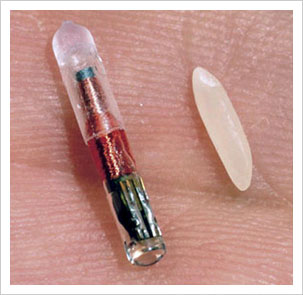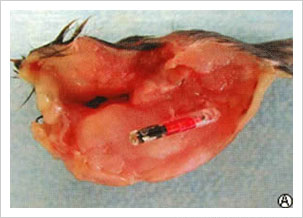ChipMeNot.org.uk - Articles
Are Pet Owners Being Misled Regarding the Safety and Reliability of Microchip Implants?
by Jeanne (on behalf of Léon, my fearless friend and noble teacher)
Microchips are being implanted in dogs and cats by veterinarians, animal shelters and breeders for identification purposes. Microchips are also being implanted by members of the public who have taken a brief microchipping course; either online or in person.
Fish, ferrets, horses, alpacas, turtles, elephants, birds, llamas, laboratory animals, zoo animals, and even snakes are being chipped.
But are microchips a reliable form of identification? And are there health risks associated with the implants?
 Microchip implant (with anti-migrational sheath) next to a grain of rice. |
Microchip implants are marketed as a safe and permanent form of identification that lasts the lifetime of the animal. They are also marketed as a way to reunite lost or stolen pets with their owners, to significantly reduce the number of pets in shelters, to identify and punish owners of dangerous dogs, and to prevent bad breeding practices and cruelty to animals.
Reasons used to promote and sell implantable microchips may sound appealing. However, before being enticed by carefully crafted advertising that is being used not only to convince people to have their animals microchipped, but also to implement mandatory animal chipping legislation, it is important to examine the facts.
Health risks
Consumers are repeatedly told that microchip implants are safe. So safe, in fact, that pharmaceutical giant Merial says scientific studies show that microchip implants are totally painless, perfectly well tolerated by the animal and that there is no risk of itchiness, allergic reactions or abscesses. Merial even claims that European experience shows that microchips are never rejected from the body. However, published scientific studies and adverse microchip reports recorded by the British Small Animal Veterinary Association (BSAVA) prove otherwise. (1-2)
Scientific studies involving mice and rats show that both test and control animals have developed aggressive and lethal microchip-induced cancerous growths: “The neoplasms induced in the present investigation are clearly due to the implanted microchips,” write the authors of “Subcutaneous Soft Tissue Tumours at the Site of Implanted Microchips in Mice.” (3)
 The microchip has been removed from the cavity where it resided in situ (size of microchip 2 x 12 mm). |
“One
of the most potentially serious disadvantages of the microchip
implantation is the possibility that foreign-body-induced tumours may
develop in long-term rodent studies.” (4) "Subcutaneous Microchip-Associated Tumours in B6C3F1 Mice: A Retrospective Study to Attempt to Determine Their Histogenesis," S. Le Calvez et al., Experimental and Toxicologic Pathology |
Scientific reports also show that small zoo animals, Damarland mole rats, an Egyptian fruit bat, a marmoset and a house musk shrew have developed microchip-associated cancerous growths. Medical reports and scientific studies also reveal that dogs and cats have developed aggressive cancerous growths at the site of their microchip implants. (5)
In 2009, a Yorkshire Terrier named Scotty developed epitheliotropic lymphoma at the site of his Schering-Plough, Home Again microchip implant. Little Scotty died within months of developing cancer; his death coincided with his sixth birthday. (6-7)
Scotty |
 |
|
|
 Scotty after removal of tumour and microchip implant. |
|
In October 2010, a lawsuit was filed in the US by Andrea Rutherford against Merck Sharp & Dohme and Digital Angel Inc. because her cat, Bulkin, developed cancer at the site of his Home Again microchip implant. (Schering-Plough sold the Home Again microchip that was provided by Digital Angel. Schering merged with Merck, which is affiliated with Merial.) The results of the lawsuit are pending. (8-9)
Some advocates of microchipping say the risk that your pet will develop cancer from a microchip implant is “negligible” to “nonexistent.” Some even say that the microchip-cancer risk is an “Internet urban legend.”
Dr. Ellen Friedman, DVM of the Newburgh Veterinary Hospital in Newburgh, NY writes:
| “There have been concerns about the implanted chip causing problems; various Internet ‘urban legends’ have tried to link microchips and a rare form of cancer. To date, we are not aware of any scientific data confirming this. In our opinion, the risk is negligible to nonexistent.” (10) |
However, ask yourself how negligible the microchip-cancer risk is if it’s your pet that develops cancer. Also ask yourself why decades of scientific data proves that an object implanted in the body can cause cancer, yet nay-sayers of the microchip-cancer risk claim that microchip implants cannot cause cancer.
Animals have also experienced neurological damage because of their microchips: “A 1.6 kg, six-week-old Tibetan Terrier was admitted with a 12-hours history of acute onset of progressive tetraparesis following insertion of a microchip to the dorsal cervical region,” write T. J. Smith and Noel Fitzpatrick of Fitzpatrick Referrals in the UK. (11-14)
Animals have also died due to the microchip implant procedure. In 2004, the BSAVA reported that a kitten died suddenly when it was chipped. “During the post mortem examination the microchip was found in the brainstem,” writes the BSAVA. (15-16)
In 2009, a young Chihuahua named Charlie Brown died within hours of being microchipped. Charlie died from “an extreme amount of bleeding” from the “little hole in the skin where the [microchip implant] needle went in,” says Dr. Reid Loken, the board-certified veterinarian who performed the procedure. (17)
Lori Ginsberg, Charlie’s owner, says, “I wasn’t in favor of getting Charlie chipped, but it was the law.” (18)
“It’s horrible to live in a country where your choices are being taken away and you don’t get to make decisions about your family and your life anymore … Politicians should not take away my right to do what is best for my pet,” says Lori Ginsberg. (19) |
When presented with cases like Scotty’s, Bulkin’s, Charlie Brown’s and others, many people justify the health risks of chipping by saying that adverse reactions to microchips are “rare.” However, as veterinarians and animal shelters are not required to report adverse or suspected adverse microchip reactions, only an extremely small number of microchip reactions are accurately reported and recorded.
When asked about the under-reporting of adverse microchip reactions, Chris Laurence (Veterinary Director of Dogs Trust, Chairman of the Microchip Advisory Group, Co-Chairman of the Pet Advisory Committee, and strong advocate of microchipping) replied, “Undoubtedly, I think drug reactions and anything where you have a voluntary reporting system is inevitably going to be under-reported. It would be stupid to deny that.” (20)
More deceptive advertising and problems with microchipping
Microchip implants are marketed as a permanent form of identification. However, they can stop working or be expelled from the animal’s body. Microchips are also known to migrate (move from the original implant site) and become lost within the body. As a result, it is impossible to identify the animal via his or her microchip.
Also, unbeknownst to the majority of pet owners, microchip numbers can be duplicated. Therefore, more than one animal can have the same identification number. Barbara Masin of Electronic Identification Devices, Ltd. (EID) and Trovan microchips says:
| “I went to the USDA listening sessions and offered to show them the problem with duplication possibilities, but they didn’t want to see it. The situation is very political. There are certain people involved within the USDA who have very close ties to certain manufacturers. There is an underlying agenda, unfortunately, and this is not for the good of the country.” (21) |
Another well-known slogan used to sell microchips is, “Microchips help reunite lost and stolen pets with their owners.” But this catchy phrase is deceptive and provides a false sense of security for pet owners who believe that their pet’s chip can be read by all microchip scanners.
Dr. Patty Khuly, VMD of the Sunset Animal Clinic in Miami, Florida warns:
| “… not all scanners are created equal. Some are better than others at reading a wide variety of microchips. That means your pet may get lost, found, scanned and euthanized if the scanner comes up ‘empty.’” (22) |
Tragically, an 8-month-old American Pit Bull Terrier named Hadden was euthanized at the Stafford County, Virginia, Animal Shelter after the scanner that was used to read his chip could not detect the implant.
Lisa Massey, Hadden’s owner, says, “They [shelter employees] just explained that they were very sorry … that they had scanned Hadden twice and nothing registered.” (23)
Another important point that pet owners must be aware of pertains to recovering their stolen microchipped pet. Specifically, if your chipped pet is stolen, the chip does not guarantee that you will find your pet. Also, recent cases in the UK reveal that the chip does not provide proof of ownership. (24-25) So, even if you locate your stolen, microchipped pet, it is possible that your pet will not be returned to you. For example, in April 2010, Dave Moorhouse was contacted by Anibase, a microchip database company, asking if he wanted to change the ownership records of his Jack Russell Terrier, Rocky. Mr. Moorhouse told Anibase that Rocky had been stolen and asked where he was. However, Anibase refused to provide information regarding Rocky’s whereabouts.
Steven Wildridge, managing director of Animalcare, the company that owns and operates Anibase, says:
| “This is not a choice, it’s an obligation under the Data Protection Act. If the individuals involved do not want us to pass on their details to the original owner then we cannot do so unless compelled to following a criminal or civil proceeding.” (26) |
Although Rocky’s microchip was registered to Mr. Moorhouse, the police concluded there was no criminal case and refused to help him find Rocky. A Huddersfield County Court judge ruled that the situation was out of his jurisdiction.
Mr. Moorhouse asks, “What’s the point of having your pet microchipped if you can’t get him back?” (27)
Those who promote and/or profit from microchips also claim that microchipping will significantly reduce the number of pets in shelters. However, this claim is not substantiated by accurate, long-term, independent studies. In fact, in the few, short-term studies that used carefully selected animal shelters to test microchips, scanners and databases, researchers noticed many limitations associated with microchip implant technology. For example, in the study “Sensitivity of Commercial Scanners to Microchips of Various Frequencies Implanted in Dogs and Cats,” Linda K. Lord, DVM, PhD and co-authors write:
| “… similar to the case in our study when microchips were scanned in vitro under controlled conditions, none of the scanners examined [including universal scanners] had 100% sensitivity for any of the microchip brands.” (28-29) |
They also write, “… microchipping … is not an infallible system, and it is not realistic to expect 100% performance.” (30)
Implantable microchips are also promoted for use in “dangerous” dogs so that their owners can be identified and held responsible for their dog’s bad behaviour. However, owners of dangerous dogs will probably find a way to avoid having their dogs chipped. Also, owners of dangerous chipped dogs could have the chip removed, either surgically or by some inhumane method, in order to avoid being identified.
Microchips are also promoted as a way to prevent bad breeding practices and cruelty to animals. A proposal has been made in Wales to implement mandatory chipping of dogs in breeding premises. RSPCA inspector Richard Abbott says the charity has found dogs in “dark, damp, ammonia-smelling” conditions with “no bedding whatsoever” and with “puppies dead or dying next to them.” (31)
Unfortunately, compulsory chipping will not prevent bad breeding practices, unhygienic conditions or cruelty to animals by bad breeders, those involved in puppy mills, or anyone else for that matter. Instead, it is likely that microchips and insertion devices will be purchased via the Internet to reduce costs, and the implant procedure will be done by insensitive, untrained individuals in stressful and unhygienic conditions. As a result, puppies will suffer and/or die due to infections, abscesses, bleeding, neurological damage and cancer caused by the implants. Meanwhile, the conditions in which the dogs and puppies live will remain the same.
Conclusion
Real-life evidence shows that microchip implants are an unreliable and potentially dangerous form of identification. In spite of the risks, microchip companies and advocates of microchipping continue to mislead pet owners by saying that microchips are reliable and safe. In addition, mandatory animal microchipping legislation continues to be enacted around the world.
It is important that pet owners educate themselves regarding problems associated with microchips, and share the information with other pet owners, veterinarians, animal shelters and those involved in microchipping policies. Pet owners should also become involved in the process of reporting adverse microchip reactions, otherwise adverse consequences of microchipping will continue to be grossly under-reported.
Pet owners should not be forced to have a microchip implanted in their
pet. Therefore, it is important to work together to reverse mandatory
microchipping legislation and prevent further microchipping legislation
from being enacted. (32)
Wishing you love, light, courage, honour and integrity.
Jeanne, on behalf of Léon and all of the animals that have warned us of problems associated with microchipping
~~~~~~~
With thanks to Jeanne for allowing us to reproduce this article here. Visit the Noble Leon wesbite for more information about chipping animals: www.noble-leon.com




